- Home
- Ernest Hemingway
Death in the Afternoon Page 17
Death in the Afternoon Read online
Page 17
Juanito Quintana, who is one of the best aficionados in the north, had written me to Madrid about Ortega telling how pleased they were to have gotten him for Pamplona and about the price his manager was demanding to produce him. He was very eager to see him and my account of his dismal performances in and around Madrid only depressed him for a moment. After we had seen him once though he was very disillusioned and after we had seen him three times Juanito could not stand to have his name mentioned.
During the summer I saw him several times more and only once was he good even in his fashion. That was in Toledo with hand-picked bulls which were so small and inoffensive that anything he did needed to be discounted. What he has, when he is good, is a lack of movement and a serenity which is phenomenal. The best pass he makes is the two-handed one designed to cut the voyage of the bull and turn him on himself, but because he does this best he does it again and again on every bull that he gets whether the bull needs this punishment or not and consequently unfits the animal for anything else. He makes a right-handed pass with the muleta, inclining his body toward the bull, very well but he does not link it up with other passes and he is still quite incapable of making effective natural passes with his left. He is very good at spinning between the bull's horns, a very silly business, and he is a waster of all the vulgarities which are substituted for the dangerous manoeuvres in bullfighting whenever the fighter knows that the public is ignorant enough to accept them. He has plenty of courage, strength and health, and friends whom I trust tell me he was truly very good at Valencia, and if he were younger and less conceited he could undoubtedly become an excellent matador if he were able to learn to use his left hand; he may, like Robert Fitzsimmons, violate all standards of age and still do this, but as a messiah he is non-existent. I would not devote so much space to him except that he has had so many thousand columns of paid publicity, some of it is very skillful, that I know that if I would have been away from Spain and only following the fights through the papers I would have probably taken him too seriously.
One bullfighter inherited the qualities of Joselito and lost his inheritance through venereal disease. Another died of bull-fighting's other occupational disorder, and a third became a coward through the first horn wound that came to test his valor. Of the two new messiahs Ortega does not convince me nor does Bienvenida, but I wish Bienvenida much luck. He is a well-brought-up, pleasant, not conceited boy and he is going through a hard time.
Old lady: You are always wishing people good luck and telling them about their mistakes and it seems to me you criticise them very meanly. How is it, young man, that you talk so much and write so long about these bullfights and yet are not a bullfighter yourself. Why did you not take up this profession if you liked it so and think you know so much about it?
Madame, I tried it in its simplest phases but without success. I was too old, too heavy and too awkward. Also my figure was the wrong shape, being thick in all the places where it should be lithe and in the ring I served as little else than target or punching dummy for the bulls.
Old lady: Did they not wound you in horrible fashion? Why are you alive to-day?
Madame, the tips of their horns were covered or blunted or I should have been opened up like a sewing basket.
Old lady: So you fought bulls with covered horns. I had thought better of you.
Fought is an exaggeration, Madame. I did not fight them but was merely tossed about.
Old lady: Did you ever have experience with bulls with naked horns? Did they not wound you grievously?
I have been in the ring with such bulls and was unwounded though much bruised since when I had compromised myself through awkwardness I would fall onto the bull's muzzle clinging to his horns as the figure clings in the old picture of the Rock of Ages and with equal passion. This caused great hilarity among the spectators.
Old lady: What did the bull do then?
If he were of sufficient force he threw me some distance. If this did not occur I rode a distance on his head, he tossing all the while, until the other amateurs had seized his tail.
Old lady: Were there witnesses to these feats you tell of? Or do you just invent them as a writer?
There are thousands of witnesses, although many may have died since from injuries to their diaphragms or other inner parts caused by immoderate laughter.
Old lady: Was it this that decided you against bullfighting as a profession?
My decision was reached on a consideration of my physical ineptitudes, on the welcome advice of my friends and from the fact that it became increasingly harder as I grew older to enter the ring happily except after drinking three or four absinthes which, while they inflamed my courage, slightly distorted my reflexes.
Old lady: Then I may take it that you have abandoned the bull ring even as an amateur?
Madame, no decision is irrevocable, but as age comes on I feel I must devote myself more and more to the practice of letters. My operatives tell me that through the fine work of Mr. William Faulkner publishers now will publish anything rather than to try to get you to delete the better portions of your works, and I look forward to writing of those days of my youth which were spent in the finest whorehouses in the land amid the most brilliant society there found. I had been saving this background to write of in my old age when with the aid of distance I could examine it most clearly.
Old lady: Has this Mr. Faulkner written well of these places?
Splendidly, Madame. Mr. Faulkner writes admirably of them. He writes the best of them of any writer I have read for many years.
Old lady: I must buy his works.
Madame, you can't go wrong on Faulkner. He's prolific too. By the time you get them ordered there'll be new ones out.
Old lady: If they are as you say there cannot be too many.
Madame, you voice my own opinion.
CHAPTER FIFTEEN
The cape in bullfighting was the original means of defense against the danger of the animal. Later, when the fiesta became formalized, its uses were to run the bull when he first came out, to take the bull away from the fallen picador and to place him before the next picador who was to receive his charge, to place him in position for the banderillas, to place him in position for the matador, and to distract his attention when any bullfighter had gotten himself into a compromising position. The whole aim and culmination of the bullfight was the final sword thrust, the moment of truth, and the cape was in principle only an adjunct used to run the bull and help towards preparing that moment.
In modern bullfighting the cape has become increasingly important and its use increasingly dangerous and the original moment of truth, or of reality, the killing, has become a very tricky business indeed. The matadors take turns in being responsible for taking the bull away from the picador and his mount and protecting the man and the horse after the bull's charge. This act of taking the bull out into the ring away from the man and horse and then, supposedly, placing him in position to charge the next picador is called the quite or removing. The matadors stand in line on the left of the horse and rider and the one who takes the bull out and away from the fallen man and horse goes to the rear of the line when he comes back from making the quite. The quite, pronounced key-tay, from being merely an act of protection for the picador, performed as quickly, as valiantly and as gracefully as possible has now become an obligation on the matador performing it after he has taken the bull out to pass the bull with the cape in whatever style he elects, but usually in veronicas, at least four times as closely, as quietly and as dangerously as he is able. A bullfighter is now judged, and paid, much more on the basis of his ability to pass the bull quietly, slowly and closely with the cape than on his ability as a swordsman. The increasing importance and demand for the style of cape work and work with the muleta, that was invented, or perfected, by Juan Belmonte; the expectation and demand that each matador pass the bull, giving a complete performance with the cape, in the quites; and the pardoning of deficiency in killing of a matador who is an ar
tist with the cape and muleta, are the main changes in modern bullfighting.
The present quite, as a matter of fact, has become almost as much a moment of truth as the killing ever was. The danger is so real, so controlled and selected by the man, and so apparent, and the slightest tricking or simulating of danger shows so clearly, that the modern quites in which the matadors rival with each other in invention and in seeing with what purity of line, how slowly, and how closely they can make the horns of the bull pass their waists, keeping him dominated and slowing the speed of his rush with the sweep of the cape controlled by their wrists; the whole hot bulk of the bull passing the man who looks down calmly where the horns almost touch, and sometimes do touch, his thighs while the bull's shoulders touch his chest, with no move of defense against the animal and no means of defense against the death that goes by in the horns except the slow movement of his arms and his judgment of distance; these passes are finer than any cape work of the past and as emotional as anything can be. It is to have an animal that they can do this with, increasing the closeness of the horns until they actually touch the man, that the bullfighters pray for a straight-charging bull, and it is the modern cape work, supremely beautiful, supremely dangerous and supremely arrogant, that has kept bullfighting popular and increasingly prosperous through a period when all was decadence and the cape the only real moment of truth. Matadors torear with the cape now as never before, the good ones have taken Belmonte's invention of working close in the bull's territory, keeping the cape low, and using only the arms and made it even better than Belmonte did, better than Belmonte if they have a bull that suits them. There has been no decadence in bullfighting in the use of the cape. There has been not a renaissance, but a constant, steady and complete improvement.
I will not describe the different ways of using the cape, the gaonera, the mariposa, the farol, or the older ways, the cambios de rodillas, the galleos, the serpentinas in the detail I have described the veronica because a description in words cannot enable you to identify them before you have seen them as a photograph can. Instantaneous photography has been brought to such a point that it is silly to try and describe something that can be conveyed instantly, as well as studied, in a picture. But the veronica is the touchstone of all cape work. It is where you can have the utmost in danger, beauty, and purity of line. It is in the veronica that the bull passes the man completely and, in bullfighting, the greatest merit is in those manoeuvres where the bull passes the man in his charge. Nearly all other passes with the cape are picturesque variations of the same principle or else are more or less tricks. The one exception to this is the quite of the mariposa, or the butterfly, invented by Marcial Lalanda. This, the photograph shows clearly what it is, partakes more of the principal of the muleta than of the cape. Its merit is when it is done slowly and when the folds of the cape that correspond to the butterfly wings swing back from the bull, moved suavely rather than snatched away, while the man shifts backward from side to side. When it is done properly each backward swing of the wings of the cape is like a pase natural with the muleta and is as dangerous. I have seen no one but Marcial Lalanda do it well. The imitators, especially the steel-sinewed, leg-jittering, eagle-nosed Vicente Barrera of Valencia, do the mariposa as though they snatched the cape from under the bull's nose by electricity. There is a good reason why they do not do it slowly. If you do it slowly there is danger of death.
Originally quites were made, preferably, by the use of largas. In these the cape was fully extended and one end offered to the bull who was drawn away following the extended cape and then turned on himself to fix him in place by a movement made by the matador who would swing the cape over his shoulder and walk away. These could be executed with great elegance. Many variations were possible. Largas could be done while the man knelt and the cape could be so swung that it would wind in the air like a snake making the so-called serpentinas and other fantasies that Rafael El Gallo did so well. But in all largas the principle was that the bull followed the loose length of the cape and was finally turned on himself and fixed by a movement of the cape's end imparted to it by the man who held the opposite extremity. Their advantage was that they turned the bull less brusquely than the two-handed passes with the cape and so kept the animal in better condition to attack during the final act.
The amount of cape work that is now done with the bull by the matadors alone is, of course, very destructive to him. If the object of the fight had remained, as it was originally, simply to put the bull in the best condition for the killing, the amount that the matadors use the cape, using both hands, would be indefensible. But as bullfighting has progressed or decayed so that the killing is now only a third of the fight rather than the whole end and the cape work and the muleta work a large two-thirds the type of bullfighter has changed. Rarely, extremely rarely, do you get a matador who is both a great killer and a great artist with either cape or muleta. As rarely as you would get a great boxer who was also a first-rate painter. To be an artist with the cape, to use it as well as it can be used, takes an aesthetic sense that can only be a handicap to a great killer. A great killer must love to kill. He must have extraordinary courage and ability to perform two distinctly different acts with two hands at the same time, much more difficult than patting your head with one hand and rubbing your stomach with the other, he must have a primitive and all-controlling sense of honor, for there are many ways to trick the killing of bulls without going straight in on them; but above all he must love to kill. To most of the bullfighters who are artists, starting with Rafael El Gallo and going on down through Chicuelo the necessity to kill seems almost regrettable. They are not matadors but toreros, highly developed, sensitive manipulators of cape and muleta. They do not like to kill, they are afraid to kill and ninety times out of a hundred they kill badly. Bullfighting has gained greatly by the art they have brought to it and one of the great artists, Juan Belmonte, learned to kill well enough. Although he was never a great killer, he had enough of the natural killer in him to develop it and such a great pride in doing everything perfectly that he finally became acceptable and secure as a killer after being deficient for a long time. But there was always a wolf look about Belmonte and there is nothing of the wolf in any of the other aestheticians that have developed since his time, and since they cannot kill honestly, since they would be driven out of bullfighting if they had to kill bulls as they should be killed, the public has taken to expecting and wanting the maximum they can give with the cape and the muleta, regardless of its final fitting of the bull for killing, and the structure of bullfighting has been changed accordingly.
Madame, does all this writing of the bullfights bore you?
Old lady: No, sir, I cannot say it does, but I can only read so much of it at one time.
I understand. A technical explanation is hard reading. It is like the simple directions which accompany any mechanical toy and which are incomprehensible.
Old lady: I would not say your book is that bad, sir.
Thank you. You encourage me, but is there nothing I can do to keep your interest from flagging?
Old lady: It does not flag. It is only that I get tired sometimes.
To give you pleasure then.
Old lady: You give me pleasure.
Thank you, Madame, but I mean in the way of writing or conversation.
Old lady: Well, sir, since we have stopped early to-day why do you not tell me a story?
About what, Madame?
Old lady: Anything you like, sir, except I would not like another one about the dead. I am a little tired of the dead.
Ah, Madame, the dead are tired too.
Old lady: No tireder than I am of hearing of them and I can speak my wishes. Do you know any of the kind of stories Mr. Faulkner writes?
A few, Madame, but told baldly they might not please you.
Old lady: Then do not tell them too baldly.
Madame, I will tell you a couple and see how short and how far from bald I can make them. What sort of s
tory would you like first?
Old lady: Do you know any true stories about those unfortunate people?
A few, but in general they lack drama as do all tales of abnormality since no one can predict what will happen in the normal while all tales of the abnormal end much the same.
Old lady: Just the same I would like to hear one. I have been reading of these unfortunate people lately and they are very interesting to me.
All right, this is a very short one, but well written it could be tragic enough, but I will not try to write it but only to tell it quickly. I was eating at the Anglo-American Press Association lunch in Paris and sat next to the man who told this story. He was a poor newspaperman, a fool, a friend of mine, and a garrulous and dull companion and he lived at a hotel too expensive for his salary. He still held his job because the circumstances which were later to demonstrate how poor a newspaperman he was had not yet arisen. He told me at lunch that he had slept very badly the night before because there had been a row going on the whole night in the room next to his at the hotel. About two o'clock some one had knocked on his door and begged to be let in. The newspaperman had opened the door and a dark-haired young man about twenty in pyjamas and a new-looking dressing gown came into the room crying. At first he was too hysterical to make much sense except to give the newspaperman the impression that something horrible had been narrowly averted. It seemed this young man had arrived with his friend in Paris on that day's boat train. The friend, who was a little older, he had met only recently, but they had become great friends and he had accepted his friend's invitation to come abroad as his guest. His friend had plenty of money and he had none and their friendship had been a fine and beautiful one until tonight. Now everything in the world was ruined for him. He was without money, he would not see Europe, at this point he sobbed again, but nothing on earth would induce him to go back into that room. He was firm on this point. He would kill himself first. He really would. Just then there was another knock on the door and the friend who was also a fine, clean-cut-looking American youth wearing an equally new and expensive looking dressing gown came into the room. On the newspaperman asking him what this was all about he said it was nothing; his friend was overwrought from the trip. At this the first friend commenced crying again and said nothing on earth would make him go back in that room. He would kill himself, he said. He would absolutely kill himself. He went back, however, finally, after some very sensible reassuring pleading by the older friend and after the newspaperman had given them each a brandy and soda and advised them to cut it all out and get some sleep. The newspaperman did not know what it was all about, he said, but thought it was something funny all right, and anyway he went to sleep himself and was next awakened by what sounded like fighting in the next room and some one saying, "I didn't know it was that. Oh, I didn't know it was that! I won't! I won't!" followed by what the newspaperman described as a despairing scream. He hammered on the wall and the noise ceased, but he could hear one of the friends sobbing. He took it to be the same one who had sobbed earlier.

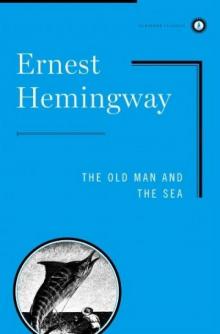 The Old Man and the Sea
The Old Man and the Sea Green Hills of Africa
Green Hills of Africa The Sun Also Rises
The Sun Also Rises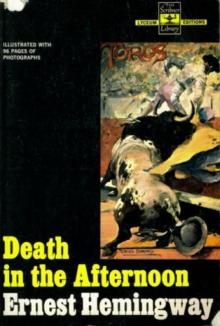 Death in the Afternoon
Death in the Afternoon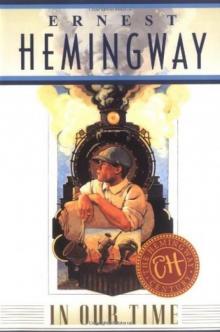 In Our Time
In Our Time For Whom the Bell Tolls
For Whom the Bell Tolls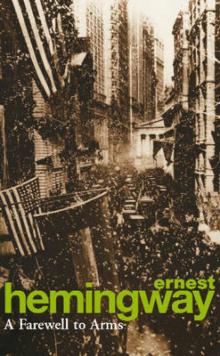 A Farewell to Arms
A Farewell to Arms A Moveable Feast
A Moveable Feast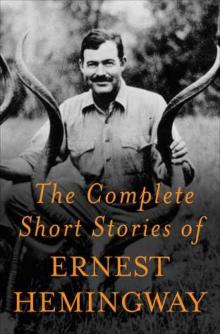 The Complete Short Stories of Ernest Hemingway
The Complete Short Stories of Ernest Hemingway Big Two-Hearted River
Big Two-Hearted River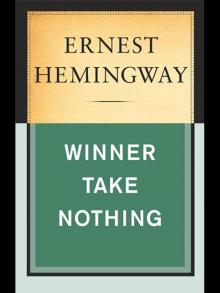 Winner Take Nothing
Winner Take Nothing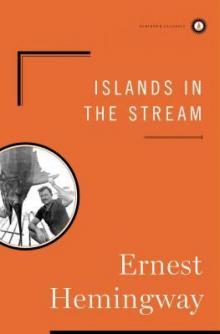 Islands in the Stream
Islands in the Stream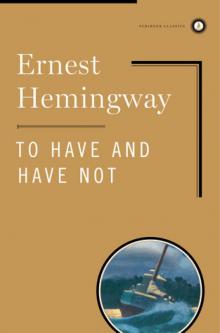 To Have and Have Not
To Have and Have Not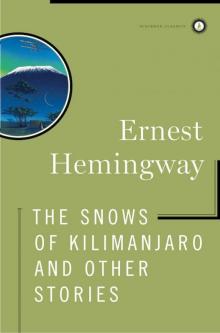 The Snows of Kilimanjaro and Other Stories
The Snows of Kilimanjaro and Other Stories Across the River and Into the Trees
Across the River and Into the Trees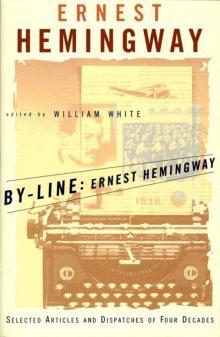 By-Line Ernest Hemingway
By-Line Ernest Hemingway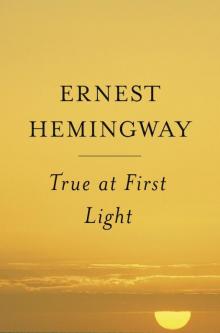 True at First Light
True at First Light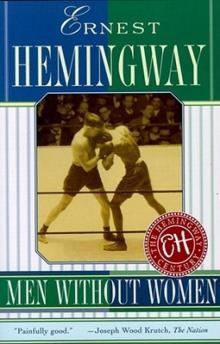 Men Without Women
Men Without Women The Nick Adams Stories
The Nick Adams Stories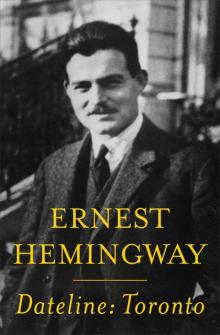 Dateline- Toronto
Dateline- Toronto The Torrents of Spring
The Torrents of Spring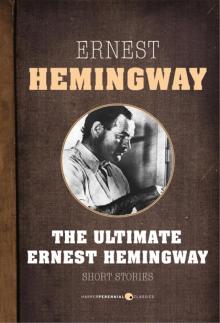 Short Stories
Short Stories